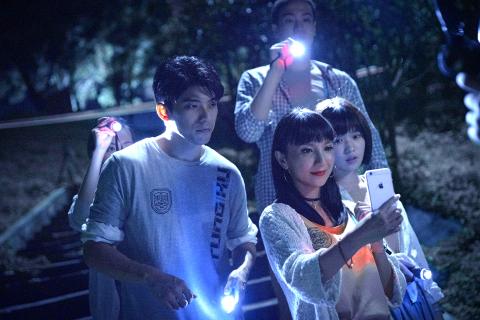The team behind The Tag-along (紅衣小女孩) and The Rope Curse (粽邪) tackle another real-life haunted legend in The Bridge Curse (女鬼橋), with promises of groundbreaking storytelling that will give a new spin to a popular but run-of-the-mill ghost tale.
The film is based on the legend of the haunted bridge at Taichung’s Tunghai University (東海大學), which has been changed to Donghu University (東湖大學) here. It’s one of those standard tales involving a female student who is supposed to meet her lover at the bridge to elope. The lover never shows, and she drowns herself in the lake. The student has haunted the bridge ever since, and it’s said that at midnight, an extra 14th step will appear on the stairs following the bridge, and whoever turns around before reaching the top will disappear.
In 2018, a Tunghai student was livestreaming at the bridge at night when viewers spotted what looked like a female ghost in white behind him and urged him to run for his life, forming the basis for the plot. The opening scene depicts a group of students preparing to livestream themselves walking up the stairs at midnight as a promotion video for a “test of courage” activity for incoming freshmen, and things go awry from the very beginning.

Photo courtesy of atmovies.com
Is the use of annoyingly shaky cell phone footage with live comments what the filmmakers refer to as revolutionary? Thankfully it isn’t, but the problem is that the film just takes way too long to start breaking from the mold to get to the final twist. The first three-quarters of the film follow a typical haunted school formula, with not very frightening jump scares and a generic female ghost that borders on the comical.
The production is (aside from the ghost) refined, making use of atmospheric shifts as well as lighting to set the mood instead of overly relying on special effects, which The Tag-along was criticized for. The acting by the up-and-coming thespians (especially Chang Ning, 張甯, and Vera Yen, 嚴正嵐) is also decent across the board. There are some subplots such as a love triangle and a female journalist investigating supernatural events, but one’s patience starts wearing thin as the film drags on.
Then things suddenly get interesting in the last 20 minutes, but everything happens so quickly with all the tantalizing, mind-bending bits jammed into the final sequences that it’s hard to keep up with the sudden downpour of revelations. No wonder many people watched the movie twice to fully understand it.
Director Lester Shih’s (奚岳隆) ability is evident in his feature debut as he skillfully utilizes various devices to conceal the secret to the very end, while dropping many subtle hints that will make sense much later — but unfortunately at the expense of the first half. This last part should have been drawn out a lot more, perhaps with the journalist playing a larger role, making the film more of a trippy, horror-tinged mystery thriller instead.
The Bridge Curse is part of what seems to be a movement in the past five years or so to make the public aware of supernatural Taiwanese folk tales, and given its box office success (NT$23 million over the 228 Peace Memorial Day long weekend), the interest is definitely there. The film has the right elements, ideas and technical capabilities, and its final twist definitely will get people talking — it just needs better structuring and could be much scarier.

Following the rollercoaster ride of 2025, next year is already shaping up to be dramatic. The ongoing constitutional crises and the nine-in-one local elections are already dominating the landscape. The constitutional crises are the ones to lose sleep over. Though much business is still being conducted, crucial items such as next year’s budget, civil servant pensions and the proposed eight-year NT$1.25 trillion (approx US$40 billion) special defense budget are still being contested. There are, however, two glimmers of hope. One is that the legally contested move by five of the eight grand justices on the Constitutional Court’s ad hoc move

Stepping off the busy through-road at Yongan Market Station, lights flashing, horns honking, I turn down a small side street and into the warm embrace of my favorite hole-in-the-wall gem, the Hoi An Banh Mi shop (越南會安麵包), red flags and yellow lanterns waving outside. “Little sister, we were wondering where you’ve been, we haven’t seen you in ages!” the owners call out with a smile. It’s been seven days. The restaurant is run by Huang Jin-chuan (黃錦泉), who is married to a local, and her little sister Eva, who helps out on weekends, having also moved to New Taipei

The Directorate-General of Budget, Accounting and Statistics (DGBAS) told legislators last week that because the Chinese Nationalist Party (KMT) and Taiwan People’s Party (TPP) are continuing to block next year’s budget from passing, the nation could lose 1.5 percent of its GDP growth next year. According to the DGBAS report, officials presented to the legislature, the 2026 budget proposal includes NT$299.2 billion in funding for new projects and funding increases for various government functions. This funding only becomes available when the legislature approves it. The DGBAS estimates that every NT$10 billion in government money not spent shaves 0.05 percent off

Dec. 29 to Jan. 4 Like the Taoist Baode Temple (保德宮) featured in last week’s column, there’s little at first glance to suggest that Taipei’s Independence Presbyterian Church in Xinbeitou (自立長老會新北投教會) has Indigenous roots. One hint is a small sign on the facade reading “Ketagalan Presbyterian Mission Association” — Ketagalan being an collective term for the Pingpu (plains Indigenous) groups who once inhabited much of northern Taiwan. Inside, a display on the back wall introduces the congregation’s founder Pan Shui-tu (潘水土), a member of the Pingpu settlement of Kipatauw, and provides information about the Ketagalan and their early involvement with Christianity. Most